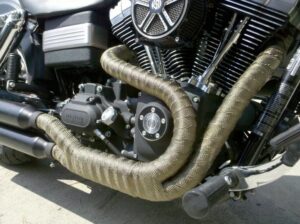1 item - $47.95
Subtotal: $47.95
Prices in AUD
Wrapping super hot engine exhaust pipes in a high temperature resistant insulating tape has become more popular recently for a number of reasons.

Kool Wrap manufacturers a range of wraps with the Basalt Titanium Wrap being the highest quality wrap in the range.
Remarkably, Basalt (often known as Lava Rock) is produced by melting down carefully chosen rock formations that are the result of volcanic activity. The molten rock is then forced through an extruding machine to produce very fine strands of glass fibre that are then woven into various products. These strands have a filament diameter of 10-20um which is far enough above the respiratory limit of 5um to make it suitable replacement for asbestos.
Basalt fibers are known to be 25% stronger than regular glass fibers and are often used in producing composites that are very similar to carbon fibre.
Wikipedia also quotes, Basalt Fibres “……….also have a high elastic modulus, resulting in excellent specific strength—three times that of steel. Thin fiber is usually used for textile applications mainly for production of woven fabric. Thicker fiber is used in filament winding, for example, for production of CNG cylinders or pipes. The thickest fiber is used for pultrusion, geogrid, UD, multiaxial fabric production and in form of chopped strand for concrete reinforcement. One of the most prospective applications for continuous basalt fiber and the most modern trend at the moment is production of basalt rebar that more and more substitutes traditional steel rebar on construction market.